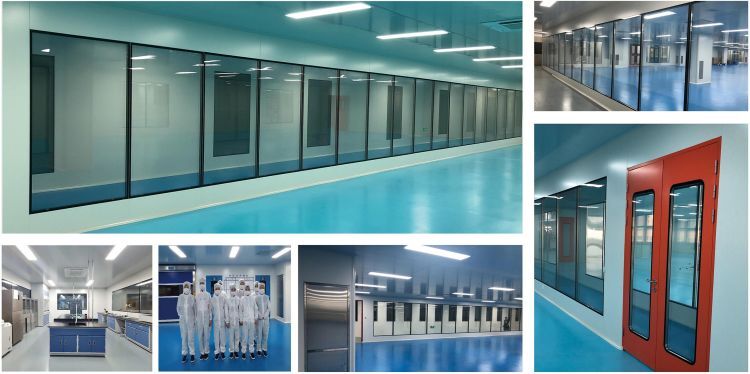Biopharmaceutical Cleanroom: Ensuring Quality and Safety in Drug Manufacturing
- 2024-01-30
- View 11
In the biopharmaceutical industry, the production of life-saving drugs and therapies demands the utmost precision and adherence to strict quality standards. One critical aspect of drug manufacturing is the use of cleanrooms specialized environments designed to maintain high levels of cleanliness, control contamination, and ensure the integrity of pharmaceutical products. This article explores the significance, design principles, and best practices of biopharmaceutical cleanrooms in safeguarding drug production and patient well-being.

Understanding Biopharmaceutical Cleanrooms
Definition and Purpose
Biopharmaceutical cleanrooms are controlled environments specifically designed for the manufacturing of pharmaceutical products, including biologics, vaccines, and other high-value drugs. These cleanrooms adhere to strict contamination control measures to ensure the safety, efficacy, and consistency of the final drug products.
Importance in Drug Manufacturing
The biopharmaceutical industry relies on cleanrooms to prevent contamination and maintain aseptic conditions during the production process. Any deviation from cleanliness standards can compromise the quality of the drugs, posing potential risks to patients' health and safety.
Cleanroom Classification and Standards
ISO Standards for Cleanrooms
Cleanrooms are classified based on ISO standards, which specify the maximum allowable particle count in the air per cubic meter. The ISO classification system ranges from ISO 1 (highest cleanliness) to ISO 9 (lowest cleanliness).
Different Cleanroom Classes
Various cleanroom classes are utilized based on the specific requirements of drug manufacturing processes. Class A cleanrooms, for instance, have the strictest particle count limits and are used for critical aseptic processes, while Class D cleanrooms are suitable for less sensitive operations.
Design and Layout of Biopharmaceutical Cleanrooms
Contamination Control
Biopharmaceutical cleanrooms are designed to minimize the introduction, generation, and retention of particles and microorganisms. This is achieved through specialized airflow patterns and meticulous design features.
Airflow Systems
Unidirectional airflow systems, such as laminar airflow, help maintain a constant and controlled direction of particle flow, preventing contamination from entering critical areas.
Material and Surface Selection
Smooth, non-porous, and easy-to-clean materials are used in cleanroom construction to minimize particle retention and facilitate thorough cleaning and disinfection.
Equipment and Technology in Biopharmaceutical Cleanrooms
Aseptic Processing Equipment
State-of-the-art aseptic processing equipment, such as isolators and barrier systems, allows drug manufacturing processes to occur within a controlled environment, reducing the risk of contamination.
Monitoring and Control Systems
Continuous monitoring of critical parameters, such as temperature, humidity, and particle counts, is essential to maintaining cleanroom conditions and identifying potential issues promptly.
Personnel Training and Gowning Procedures
Gowning Protocols
Strict gowning procedures are enforced to ensure that cleanroom personnel do not contribute to contamination. Properly fitted and sanitized cleanroom garments are worn to minimize the release of particles and microorganisms.
Training and Qualification
Cleanroom personnel undergo extensive training to understand cleanroom protocols, aseptic techniques, and the importance of adhering to cleanliness standards.
Cleaning and Disinfection in Biopharmaceutical Cleanrooms
Regular Cleaning Schedules
Routine cleaning and disinfection are carried out using appropriate agents and methods to maintain a sterile environment within the cleanroom.
Cleaning Agents and Methods
Cleaning agents must be compatible with the cleanroom materials and effective in removing contaminants without leaving residues.
Quality Assurance and Regulatory Compliance
GMP Guidelines
Good Manufacturing Practices (GMP) are followed meticulously to ensure that biopharmaceutical cleanrooms meet the highest quality standards.
Auditing and Validation
Cleanrooms undergo regular audits and validation procedures to confirm compliance with cleanliness standards and regulatory requirements.
Common Challenges in Biopharmaceutical Cleanrooms
Contamination Control
Controlling contamination remains a constant challenge, requiring vigilant monitoring and adherence to protocols.
Facility Expansion and Upgrades
As the demand for biopharmaceutical products grows, cleanroom facilities may need expansion and technology upgrades to meet production demands.
Future Trends in Biopharmaceutical Cleanrooms
Automation and Robotics
The integration of automation and robotics will continue to enhance cleanroom operations, reducing human intervention and contamination risks.
Single-Use Technologies
The adoption of single-use technologies will simplify cleaning and validation processes, improving the efficiency of cleanroom operations.
Conclusion
Biopharmaceutical cleanrooms play a pivotal role in ensuring the safety and quality of life-saving drugs and therapies. By adhering to strict contamination control measures, following GMP guidelines, and incorporating advanced technologies, these cleanrooms remain at the forefront of drug manufacturing, safeguarding patient well-being and advancing medical science.
Kwang Cleanroom is proud to offer examples of a variety of our cleanroom projects below. ISO Clean Room, Cleanroom Packaging Services, Clean Room Installation, Dust-Free Room, Dust-Free Clean Room Equipment, Pharmacy Clean Room, Hospital Operating Theater Room.
